     
|
El Pont-de-Montvert, etapa del GR®70 Camino Stevenson
|
     
|
El Pont-de-Montvert es una etapa importante y históricamente rica del GR 70, el Camino de Stevenson, situado en el departamento de Lozère. Este pintoresco pueblo es magníficamente atravesado por las aguas tumultuosas del Tarn naciente, cruzado por un puente de granito medieval que da nombre a la localidad. El escritor Robert Louis Stevenson hizo una parada aquí en 1878 con su asna Modestine, inmortalizando el lugar en su relato de viaje a través de las Cévennes.

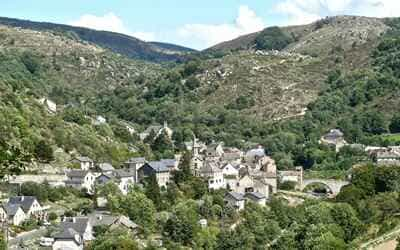 Tarde... Sin precipitaciones, tras haber bajado por un delicado valle y cruzado un arroyo burbujeante, llegamos al Pont-de-Montvert, un pueblo casi costero, situado
sobre el Tarn. El corazón se desacelera tras el esfuerzo y el sol alegre ahuyenta las nubes. Aquí, en tierras camisardas, el ánimo veraniego se impone al recuerdo de las guerras de religión. Aquí, aquellos a quienes se
les llamaba los locos de Dios pusieron fin a la vida y las acciones del abad du Chayla, un sacerdote católico furioso y cruel. En su casa del Pont, el abad encarcelaba a los protestantes
rebeldes que se negaban a abjurar. Abraham Mazel, profeta inspirado por la Biblia y la palabra divina, se convirtió en el escriba de la venganza celestial.
Tarde... Sin precipitaciones, tras haber bajado por un delicado valle y cruzado un arroyo burbujeante, llegamos al Pont-de-Montvert, un pueblo casi costero, situado
sobre el Tarn. El corazón se desacelera tras el esfuerzo y el sol alegre ahuyenta las nubes. Aquí, en tierras camisardas, el ánimo veraniego se impone al recuerdo de las guerras de religión. Aquí, aquellos a quienes se
les llamaba los locos de Dios pusieron fin a la vida y las acciones del abad du Chayla, un sacerdote católico furioso y cruel. En su casa del Pont, el abad encarcelaba a los protestantes
rebeldes que se negaban a abjurar. Abraham Mazel, profeta inspirado por la Biblia y la palabra divina, se convirtió en el escriba de la venganza celestial.
Con Laporte, Esprit Seguier, Salamon Couderc, Jean Rampon y Nicolas Joini - apodados los jefes del espíritu - se convirtió en el brazo vengador el 24 de julio de 1702. Tras
haber reclamado al abad los hermanos prisioneros, quemaron la casa y atraparon al buen hombre.
El abad du Chayla se negó a orar por su
perdón y pereció bajo el sable de Esprit Seguier. Este lo golpeó en la cabeza y Joini lo imitó. Según los inspirados, el Señor así lo había requerido.
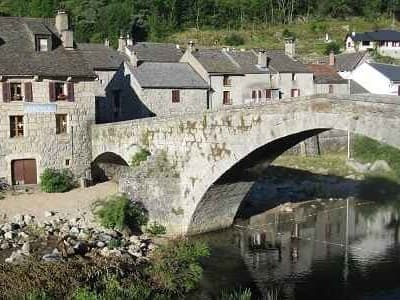 Detrás del abad, los Camisards luchaban contra Luis XIV y la revocación del edicto de Nantes, teniendo como únicas
armas sables, llamas y profecías. Todas sus misiones eran comandadas por el espíritu divino. Durante cuatro días, la tropa protestante quemó iglesias y castillos, respondió diente por diente a
las vejaciones, asesinando en el camino a dos eclesiásticos. La copa estaba llena. Demasiados templos destruidos, torturas absurdas y creyentes en galeras...
Detrás del abad, los Camisards luchaban contra Luis XIV y la revocación del edicto de Nantes, teniendo como únicas
armas sables, llamas y profecías. Todas sus misiones eran comandadas por el espíritu divino. Durante cuatro días, la tropa protestante quemó iglesias y castillos, respondió diente por diente a
las vejaciones, asesinando en el camino a dos eclesiásticos. La copa estaba llena. Demasiados templos destruidos, torturas absurdas y creyentes en galeras...
Cuatro días después del asesinato del abad, Esprit Seguier fue arrestado en Plant de Fontmort por las tropas del rey, juzgado en Florac y ejecutado al pie de la torre del reloj del
Pont-de-Montvert, donde había perecido el abad. Abraham Mazel relata en sus memorias el excepcional coraje de Seguier. Le cortaron la mano, él ofreció la otra. Se dice que incluso desgarró con sus
dientes los trozos de carne que colgaban de su muñeca. Mientras encendían la hoguera, comenzó a cantar. Nada lo hizo callar, ni las llamas ni el miedo al infierno. En su último aliento,
Esprit Seguier predijo que el lugar donde moría sería arrastrado por las aguas. Mazel cuenta que poco después, el Tarn hirvió, salió de su lecho y se llevó dicho lugar...
Durante dos años, los camisards
se atrincheraron en el desierto, nombre dado a sus lugares de culto en plena naturaleza. A veces lograban hacer frente a las tropas del rey, en una lucha en la que, tras Esprit, Seguier, otros
jefes debían destacarse: Roland, Cavalier, guerreros de Dios con un ardor inquebrantable y una fe ejemplar...
Cuando la torre del reloj y el puente aparecen bajo la luz del verano, uno cree ver el puente de Mostar, Mostar el otomano, bombardeado y destruido por los croatas - allí
donde incluso los serbios se habían abstenido.
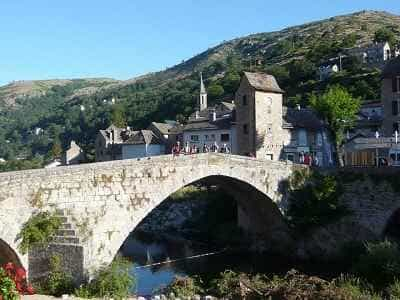 En noviembre de 1993, el Stari Most, construcción turca del siglo XVII, el viejo, como lo apodaban las poblaciones croatas, musulmanas y serbias que habían resistido
a las invasiones, a los temblores de tierra y a los años, dio su alma tras dos días de bombardeos. La guerra partió en dos la ciudad más mixta y tolerante de Herzegovina. Allí se
bebía té en los zocos, se saltaba desde el viejo puente.
En noviembre de 1993, el Stari Most, construcción turca del siglo XVII, el viejo, como lo apodaban las poblaciones croatas, musulmanas y serbias que habían resistido
a las invasiones, a los temblores de tierra y a los años, dio su alma tras dos días de bombardeos. La guerra partió en dos la ciudad más mixta y tolerante de Herzegovina. Allí se
bebía té en los zocos, se saltaba desde el viejo puente.
En la biblioteca o en las terrazas de los
cafés, se leía a Danilo Kis e Ivo Andric, dos poetas descreídos, incrédulos ante los "trenes de la historia". Danilo Kis aborda las ideologías dominantes y los príncipes. Antes que él, Ivo Andric había soñado con
una ciudad de tolerancia y con un puente como un paso de Oriente a Occidente. Su libro "Un puente sobre el Drina" es la historia profética de esa tolerancia. Ahora, Mostar es símbolo de absurdo y de
sufrimiento, y el Neretva, "mundo", fluye y llora. Y la gente llora su puente. Atrapados en el Este, en la orilla izquierda, los musulmanes recuerdan antes de la guerra. Antes de las bombas, antes de los
cuerpos apilados. Cuando no importaba quién era musulmán, quién era croata. En las calles vacías, los niños juegan a los soldados entre las ruinas, indiferentes, despreciando la guerra.
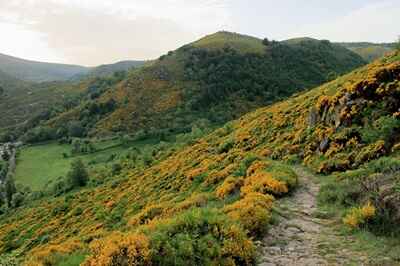 La vieja ciudad está casi destruida. Las callejuelas, el bazar, los cafés, la mezquita, los teatros, la biblioteca y el puente han desaparecido. Mi hermano bereber, Mohamed
Grim, me enseñó a compartir el pan y la sal en un espíritu de tolerancia, respeto mutuo y fraternidad ejemplar. Con Fehrat el Kabyle, cantan... penetra en mi corazón: era mi
infancia / Era la guerra. "En el Pont-de-Montvert, hay sol y creyentes que se hablan. En Mostar, la ciudad, campeona en el historial de la destrucción, sana sus heridas. El alma de la ciudad
ha huido a lo largo del Neretva. Lejos de los arcos del viejo puente...
La vieja ciudad está casi destruida. Las callejuelas, el bazar, los cafés, la mezquita, los teatros, la biblioteca y el puente han desaparecido. Mi hermano bereber, Mohamed
Grim, me enseñó a compartir el pan y la sal en un espíritu de tolerancia, respeto mutuo y fraternidad ejemplar. Con Fehrat el Kabyle, cantan... penetra en mi corazón: era mi
infancia / Era la guerra. "En el Pont-de-Montvert, hay sol y creyentes que se hablan. En Mostar, la ciudad, campeona en el historial de la destrucción, sana sus heridas. El alma de la ciudad
ha huido a lo largo del Neretva. Lejos de los arcos del viejo puente...
En el Pont-de-Montvert, las bóvedas son menos
impresionantes que en Mostar. Sin embargo, los puentes parecen gemelos: misma voluta, misma textura - los puentes tienen voz -, misma elegancia... En el pueblo que conecta dos valles, es bien
imposible en esta tarde imaginar los dragones del rey y las represiones religiosas. La dulzura de vivir y de rezar en paz ha recuperado hace tiempo su derecho de ciudadanía.
Los católicos y los protestantes se casan juntos. El domingo por la mañana cada uno regresa a su lugar de culto. Una mitad de la población al templo, la segunda a la
iglesia y los restantes dispersos en los dos bares del pueblo. Tras el oficio, los practicantes se unen a la mesa familiar para las festividades abundantes y dominicales. Mientras el sol
disminuye, el brillante Tarn se desliza por el valle y vocaliza. Los acantilados protectores que rodean el delicado pueblo lo convierten hoy en la parada más agradable.
El Camino Stevenson atraviesa todo el pueblo. Está lloviendo. El Tarn sube y retumba. Aprendo el significado de la palabra "torrencial". Las aguas giran y rugen. La
montaña vomita flujos furiosos. Las nubes imponen su ley. Bajo las corrientes, el Pont retoma su aspecto de pueblo enclavado. Las puertas se cierran. En el café, los clientes hablan de setas - "con
este tiempo, no tendrán problemas para penetrar la tierra" - y de la caza del día anterior. Conversaciones de zinc... Se comenta la historia de ese tipo que mató un caballo, creyendo que era un pato; y de
ese otro que disparó a su amigo escondido en un matorral, convencido de estar cara a cara con un jabalí.
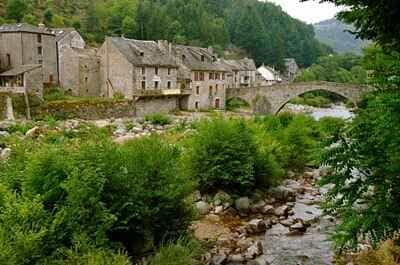 Para terminar, nos consolamos: - No hay que quejarse, el año pasado, a la misma época, nevaba. Dado que este año solo es el diluvio universal, brindemos por nuestras malas fortunas antes de la excursión al pueblo inundado.
Nos habían advertido: El Pont-de-Montvert es una escala. La Lozère está muriendo. Los comerciantes y los habitantes del pueblo se lamentan. En verano, es casi la Costa Azul; en invierno, Siberia. Eso lo dice la
camarera.
Para terminar, nos consolamos: - No hay que quejarse, el año pasado, a la misma época, nevaba. Dado que este año solo es el diluvio universal, brindemos por nuestras malas fortunas antes de la excursión al pueblo inundado.
Nos habían advertido: El Pont-de-Montvert es una escala. La Lozère está muriendo. Los comerciantes y los habitantes del pueblo se lamentan. En verano, es casi la Costa Azul; en invierno, Siberia. Eso lo dice la
camarera.
La casa del abad du Chayla...
Podría ser cualquier edificio; de hecho, los habitantes del Pont se divierten engañando a los visitantes mostrándoles cada vez una fachada diferente. Los Pontois se improvisan guías y conferenciantes... Los turistas crédulos, vestidos como marineros bretones, siempre han amado las piedras con fechas. Aquí, la casa del Chayla, no les importa y pueden prescindir de ella. Además, ya no existe; la Historia ha hecho tabla rasa de las crueldades pasadas. La casa maldita donde comenzaron dos años de masacre es un mal recuerdo. Estorbaba en la calzada y dificultaba el tráfico automovilístico, así que la hemos reemplazado por una construcción anónima que sabe ceder el paso a los vehículos todoterreno los días de caza y a los descapotables los días de turismo. Solo queda la bodega y el jardín donde prosperan coles y lechugas de buen tamaño. Un huerto reemplaza la terraza original donde cayó el horrible sacerdote. Una calabaza crece en este lugar.
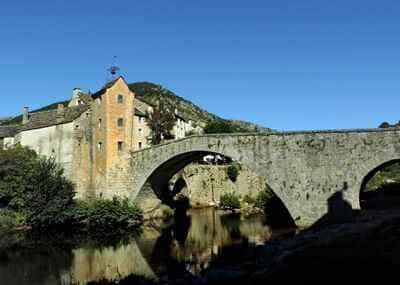 El templo, al caer la noche.
El templo, al caer la noche.
Stevenson nota el templo desde su llegada, pero no especifica si lo visitó. Sin embargo, era uno de los motivos confesados del viaje. Deseaba conocer a los protestantes, a quienes compara con
los covenantaires escoceses —los presbiterianos opuestos a las obligaciones católicas y anglicanas.
Desde Pont-de-Montvert, Stevenson comienza a rastrear la Historia. Ha traído Los Padres del desierto de Napoleón Peyrat, libros de Michelet y diversas historias.
Estudioso, anota, compila, retoma los textos y los organiza a su manera, sin dudar en copiar algunas inexactitudes.
Cuando llega, a Florac, a lo que él llama la Cévenne de las Cévennes, olvida el viaje y empieza a contar las guerras de religión. En la ignorancia y la duda, no lo sigo mucho en este terreno. La historia de los Camisards es asunto
de análisis eruditos, y quien desee aprender más sobre los inspirados o los profetas del desierto puede hoy leer los trabajos de Philippe Joutard. Hijo de presbiteriano escocés, Robert Louis Stevenson no es historiador. Narra a su manera, romántica y flamboyante. Una emoción extraña y casi lírica invade al lector cuando relata el interrogatorio de Esprit
Seguier. El escritor se dirige a su lector:
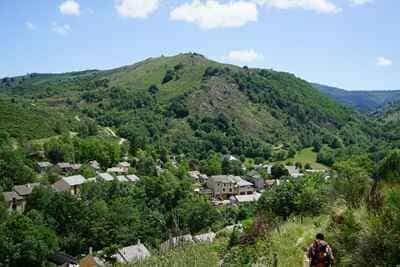 Y tal vez, si pudieras leer en mí mismo y si yo pudiera leer en tu conciencia, nuestro mutuo autocontrol no sería tan sorprendente. Stevenson presenta al personaje de Seguier como en una novela, describe a un héroe orgulloso e inspirado que desafía una vez más a la Iglesia católica, sus dogmas y sus
violencias. Nos permite escuchar las últimas palabras antes de la condena a muerte:
Y tal vez, si pudieras leer en mí mismo y si yo pudiera leer en tu conciencia, nuestro mutuo autocontrol no sería tan sorprendente. Stevenson presenta al personaje de Seguier como en una novela, describe a un héroe orgulloso e inspirado que desafía una vez más a la Iglesia católica, sus dogmas y sus
violencias. Nos permite escuchar las últimas palabras antes de la condena a muerte:
- ¿Su nombre?
- Pierre Seguier.
- ¿Por qué se le llama Esprit?
- Porque el Espíritu del Señor habita en mí.
- ¿Su domicilio?
- En última instancia, el desierto y, pronto, en el cielo.
- ¿No tiene remordimientos por sus crímenes?
- No he cometido ninguno. Mi alma es como un jardín lleno de glorietas y fuentes.
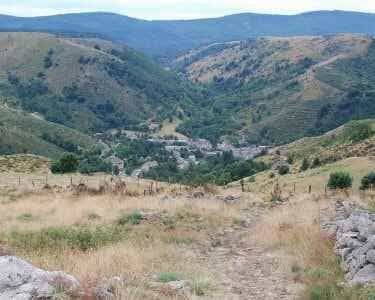 Seguier, precisa Stevenson, se creía a la derecha de Dios. A diferencia de los covenantaires escoceses que tuvieron problemas con el diablo, Stevenson considera a los protestantes franceses como creyentes con la conciencia tranquila, a pesar de la sangre. Para respaldar sus afirmaciones, anota el testimonio de un viejo camisard... "Corríamos cuando escuchábamos el canto de los salmos, corríamos como si tuviéramos alas. Sentíamos, en lo más íntimo de nosotros, un fervor exaltante, un deseo que nos levantaba." Las palabras no pueden traducir nuestros sentimientos. Stevenson parece compartir la fe del testigo. El camisard continúa: "Es algo que hay que haber sentido para comprenderlo. Por agotados que pudiéramos estar, ya no pensábamos en nuestra fatiga y nos entusiasmábamos en cuanto el canto de los salmos llegaba a nuestros oídos."
Seguier, precisa Stevenson, se creía a la derecha de Dios. A diferencia de los covenantaires escoceses que tuvieron problemas con el diablo, Stevenson considera a los protestantes franceses como creyentes con la conciencia tranquila, a pesar de la sangre. Para respaldar sus afirmaciones, anota el testimonio de un viejo camisard... "Corríamos cuando escuchábamos el canto de los salmos, corríamos como si tuviéramos alas. Sentíamos, en lo más íntimo de nosotros, un fervor exaltante, un deseo que nos levantaba." Las palabras no pueden traducir nuestros sentimientos. Stevenson parece compartir la fe del testigo. El camisard continúa: "Es algo que hay que haber sentido para comprenderlo. Por agotados que pudiéramos estar, ya no pensábamos en nuestra fatiga y nos entusiasmábamos en cuanto el canto de los salmos llegaba a nuestros oídos."
A mi turno, en el templo vacío, blanco, escucho los salmos. Estoy solo. En el silencio y la sobriedad ejemplar, revivo la cruz hugonote que lleva al cuello la madre de mis hijos. Un católico y una protestante. A la espera del bautismo, nuestros hijos harán su elección. El alma como "un jardín lleno de glorietas y fuentes". No soy historiador, apenas poeta. A falta de ser protestante, soy penitente. "La roca es dura como la sangre / Los creyentes tienen el alma de luchadores."
Más tarde, en el camino, Stevenson confía a su libro: Confieso haber encontrado a estos protestantes con placer y con la impresión de estar como en familia. El templo mudo parece susurrar las mismas palabras. Cada uno puede entrar, disfrutar del refugio y prestar oído. Valiente compañía, escuchen los cantos de antaño, canten a todo pulmón y mediten a pesar del frío. Oren en conjunto. Los dioses les han dado un corazón. Esta es mi oración. Mañana, en el corazón de los bosques, estaremos en el desierto. Las cavernas, los bosques y los campos, las playas y el lecho de los ríos servirán para mi oración. Creyendo en Esprit Seguier y practicando san José Delteil, me dirigiré a quien quiera oírme. por Eric Poindron. Extracto de "Bellas estrellas" Con Stevenson en las Cévennes, colección Gulliver, dirigida por Michel Le Bris, Flammarion.
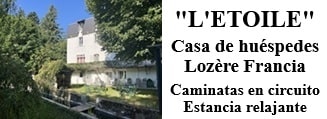
Antiguo hotel de vacaciones con un jardín a orillas del Allier, L'Etoile Casa de Huéspedes se encuentra en La Bastide-Puylaurent entre la Lozère, la Ardèche y las Cevenas en las montañas del sur de Francia. En la intersección de los GR®7, GR®70 Camino Stevenson, GR®72, GR®700 Camino Régordane, GR®470 Fuentes y Gargantas del Allier, GRP® Cévenol, Montaña Ardéchoise, Margeride. Numerosas rutas en bucle para senderismo y excursiones en bicicleta de un día. Ideal para una estancia de relax y senderismo.
Copyright©etoile.fr

 Tarde... Sin precipitaciones, tras haber bajado por un delicado valle y cruzado un arroyo burbujeante, llegamos al Pont-de-Montvert, un pueblo casi costero, situado
sobre el Tarn. El corazón se desacelera tras el esfuerzo y el sol alegre ahuyenta las nubes. Aquí, en tierras camisardas, el ánimo veraniego se impone al recuerdo de las guerras de religión. Aquí, aquellos a quienes se
les llamaba los locos de Dios pusieron fin a la vida y las acciones del abad du Chayla, un sacerdote católico furioso y cruel. En su casa del Pont, el abad encarcelaba a los protestantes
rebeldes que se negaban a abjurar. Abraham Mazel, profeta inspirado por la Biblia y la palabra divina, se convirtió en el escriba de la venganza celestial.
Tarde... Sin precipitaciones, tras haber bajado por un delicado valle y cruzado un arroyo burbujeante, llegamos al Pont-de-Montvert, un pueblo casi costero, situado
sobre el Tarn. El corazón se desacelera tras el esfuerzo y el sol alegre ahuyenta las nubes. Aquí, en tierras camisardas, el ánimo veraniego se impone al recuerdo de las guerras de religión. Aquí, aquellos a quienes se
les llamaba los locos de Dios pusieron fin a la vida y las acciones del abad du Chayla, un sacerdote católico furioso y cruel. En su casa del Pont, el abad encarcelaba a los protestantes
rebeldes que se negaban a abjurar. Abraham Mazel, profeta inspirado por la Biblia y la palabra divina, se convirtió en el escriba de la venganza celestial. Detrás del abad, los Camisards luchaban contra Luis XIV y la revocación del edicto de Nantes, teniendo como únicas
armas sables, llamas y profecías. Todas sus misiones eran comandadas por el espíritu divino. Durante cuatro días, la tropa protestante quemó iglesias y castillos, respondió diente por diente a
las vejaciones, asesinando en el camino a dos eclesiásticos. La copa estaba llena. Demasiados templos destruidos, torturas absurdas y creyentes en galeras...
Detrás del abad, los Camisards luchaban contra Luis XIV y la revocación del edicto de Nantes, teniendo como únicas
armas sables, llamas y profecías. Todas sus misiones eran comandadas por el espíritu divino. Durante cuatro días, la tropa protestante quemó iglesias y castillos, respondió diente por diente a
las vejaciones, asesinando en el camino a dos eclesiásticos. La copa estaba llena. Demasiados templos destruidos, torturas absurdas y creyentes en galeras... En noviembre de 1993, el Stari Most, construcción turca del siglo XVII, el viejo, como lo apodaban las poblaciones croatas, musulmanas y serbias que habían resistido
a las invasiones, a los temblores de tierra y a los años, dio su alma tras dos días de bombardeos. La guerra partió en dos la ciudad más mixta y tolerante de Herzegovina. Allí se
bebía té en los zocos, se saltaba desde el viejo puente.
En noviembre de 1993, el Stari Most, construcción turca del siglo XVII, el viejo, como lo apodaban las poblaciones croatas, musulmanas y serbias que habían resistido
a las invasiones, a los temblores de tierra y a los años, dio su alma tras dos días de bombardeos. La guerra partió en dos la ciudad más mixta y tolerante de Herzegovina. Allí se
bebía té en los zocos, se saltaba desde el viejo puente. La vieja ciudad está casi destruida. Las callejuelas, el bazar, los cafés, la mezquita, los teatros, la biblioteca y el puente han desaparecido. Mi hermano bereber, Mohamed
Grim, me enseñó a compartir el pan y la sal en un espíritu de tolerancia, respeto mutuo y fraternidad ejemplar. Con Fehrat el Kabyle, cantan... penetra en mi corazón: era mi
infancia / Era la guerra. "En el Pont-de-Montvert, hay sol y creyentes que se hablan. En Mostar, la ciudad, campeona en el historial de la destrucción, sana sus heridas. El alma de la ciudad
ha huido a lo largo del Neretva. Lejos de los arcos del viejo puente...
La vieja ciudad está casi destruida. Las callejuelas, el bazar, los cafés, la mezquita, los teatros, la biblioteca y el puente han desaparecido. Mi hermano bereber, Mohamed
Grim, me enseñó a compartir el pan y la sal en un espíritu de tolerancia, respeto mutuo y fraternidad ejemplar. Con Fehrat el Kabyle, cantan... penetra en mi corazón: era mi
infancia / Era la guerra. "En el Pont-de-Montvert, hay sol y creyentes que se hablan. En Mostar, la ciudad, campeona en el historial de la destrucción, sana sus heridas. El alma de la ciudad
ha huido a lo largo del Neretva. Lejos de los arcos del viejo puente... Para terminar, nos consolamos: - No hay que quejarse, el año pasado, a la misma época, nevaba. Dado que este año solo es el diluvio universal, brindemos por nuestras malas fortunas antes de la excursión al pueblo inundado.
Nos habían advertido: El Pont-de-Montvert es una escala. La Lozère está muriendo. Los comerciantes y los habitantes del pueblo se lamentan. En verano, es casi la Costa Azul; en invierno, Siberia. Eso lo dice la
camarera.
Para terminar, nos consolamos: - No hay que quejarse, el año pasado, a la misma época, nevaba. Dado que este año solo es el diluvio universal, brindemos por nuestras malas fortunas antes de la excursión al pueblo inundado.
Nos habían advertido: El Pont-de-Montvert es una escala. La Lozère está muriendo. Los comerciantes y los habitantes del pueblo se lamentan. En verano, es casi la Costa Azul; en invierno, Siberia. Eso lo dice la
camarera. El templo, al caer la noche.
El templo, al caer la noche. Y tal vez, si pudieras leer en mí mismo y si yo pudiera leer en tu conciencia, nuestro mutuo autocontrol no sería tan sorprendente. Stevenson presenta al personaje de Seguier como en una novela, describe a un héroe orgulloso e inspirado que desafía una vez más a la Iglesia católica, sus dogmas y sus
violencias. Nos permite escuchar las últimas palabras antes de la condena a muerte:
Y tal vez, si pudieras leer en mí mismo y si yo pudiera leer en tu conciencia, nuestro mutuo autocontrol no sería tan sorprendente. Stevenson presenta al personaje de Seguier como en una novela, describe a un héroe orgulloso e inspirado que desafía una vez más a la Iglesia católica, sus dogmas y sus
violencias. Nos permite escuchar las últimas palabras antes de la condena a muerte:
 Seguier, precisa Stevenson, se creía a la derecha de Dios. A diferencia de los covenantaires escoceses que tuvieron problemas con el diablo, Stevenson considera a los protestantes franceses como creyentes con la conciencia tranquila, a pesar de la sangre. Para respaldar sus afirmaciones, anota el testimonio de un viejo camisard... "Corríamos cuando escuchábamos el canto de los salmos, corríamos como si tuviéramos alas. Sentíamos, en lo más íntimo de nosotros, un fervor exaltante, un deseo que nos levantaba." Las palabras no pueden traducir nuestros sentimientos. Stevenson parece compartir la fe del testigo. El camisard continúa: "Es algo que hay que haber sentido para comprenderlo. Por agotados que pudiéramos estar, ya no pensábamos en nuestra fatiga y nos entusiasmábamos en cuanto el canto de los salmos llegaba a nuestros oídos."
Seguier, precisa Stevenson, se creía a la derecha de Dios. A diferencia de los covenantaires escoceses que tuvieron problemas con el diablo, Stevenson considera a los protestantes franceses como creyentes con la conciencia tranquila, a pesar de la sangre. Para respaldar sus afirmaciones, anota el testimonio de un viejo camisard... "Corríamos cuando escuchábamos el canto de los salmos, corríamos como si tuviéramos alas. Sentíamos, en lo más íntimo de nosotros, un fervor exaltante, un deseo que nos levantaba." Las palabras no pueden traducir nuestros sentimientos. Stevenson parece compartir la fe del testigo. El camisard continúa: "Es algo que hay que haber sentido para comprenderlo. Por agotados que pudiéramos estar, ya no pensábamos en nuestra fatiga y nos entusiasmábamos en cuanto el canto de los salmos llegaba a nuestros oídos."